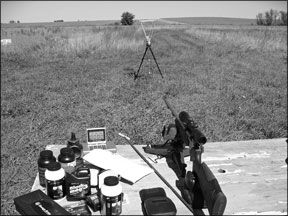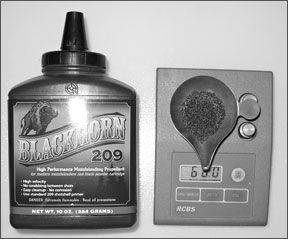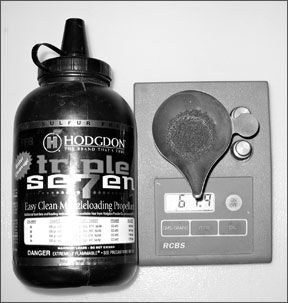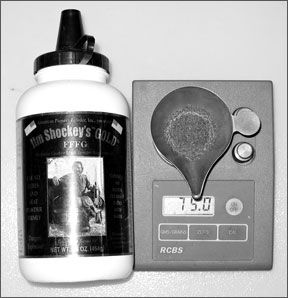Muzzleloading propellants have lagged behind propellants in cartridges for some time, this despite the great increase in inline popularity and use that continues today. Sulfur-based propellants are hygroscopic and filthy, promoting gun corrosion, requiring immediate cleaning, and are horribly inefficient. Blackpowder, a mixture not a compound, leaves behind about 50% of itself as fouling. Performance- and convenience-minded sportsmen have long looked for a better way.

The prevalent blackpowder replacement for decades has been Pyrodex. Though synthetic, it also contains sulfur and generates sulfur salts that continue the corrosion problem. In the opinion of many muzzleloading enthusiasts, it is even worse than blackpowder in the corrosion and cleaning departments. Yet, for many years that is what muzzleloading shooters have been stuck with.
Over the years, various volumetrically measured gas-generating compounds have been introduced. Due to marketing problems, production problems, and quality-control problems, many of these products have vanished from the marketplace. This includes such products as Black Canyon, CleaR-Shot, and various other compounds. So, with this history behind us, what are the best muzzleloading propellants today?
The Candidates
To define and compare the attributes of current sulfurless muzzleloading propellants, we selected three distinct products: Blackhorn 209, a new propellant introduced by Western Powder Company; Triple Se7en, introduced by Hodgdon Powder in 2002 and enjoying success in the marketplace; and Shockeys Gold, produced by American Pioneer.
Using major catalog retailer street pricing, we found Triple Se7en FFg sells for $26 per 1-pound bottle, and Shockeys Gold at $20 per pound. The new Blackhorn 209, which isnt in wide retail distribution, is estimated to sell for $29 for a 10-ounce bottle. Powder manufacturers rarely publish retail pricing, and local pricing can vary widely based on the season. Complicating the matter is that while sold by weight, these propellants are often measured by volume. Cost per shot is a more valid means of comparison, and cost per shot at the same velocity even more relevant.

A variety of muzzleloading rifles were tested with these propellants: a Knight RB, a Knight KP1, a Savage 10ML-II, a Thompson Contender G2, and a Thompson Encore-all in .50 caliber. But to compile head-to-head velocity data, our testers then shot the loads over a CED Millennium M2, setting the first screen 5 yards from the muzzle. We used a Knight KRB Rolling Block as our test rifle, shooting all the powders on the same 42-degree day. The primers used were Federal 209A shotshell primers. All volumetric loads were 100 grains by volume using a Thompson/Center U-View powder measure. The primary test bullet was a Barnes TMZ 290-grain saboted boattail.
Accuracy Testing
In 100-yard accuracy testing using the Barnes TMZ 209 projectile, we found that Triple Se7en produced 1.5-inch groups in our Thompson Encore, with Blackhorn 209 producing similar results. Shockeys Gold could not do better than 2.75- to to 3-inch groups. Blackhorn 209 gave us 1.25-inch 100 yard groups with the Knight KP1, and the Savage 10ML-II gave us 0.9- to 1-inch 100-yard groups with Blackhorn 209.
The velocities clocked out of the KRB were a bit slower than other rifles; however, it was important to use identical testing protocol for all of these powders-which is exactly what we did. Muzzleloading hunters should have no problem achieving muzzle velocities around 1750 fps with 300-grain sabots or 1850 fps with 250-grain sabots, contingent on rifle and usable bore length with either Blackhorn 209 or Triple Se7en. Also, we should note that Hodgdon calls 100 grains by volume of Triple Se7en a “max load,”

while Western Powders calls 120 grains by volume of Blackhorn 209 a “max load.” Muzzleloading rifle manufacturers have their own notions, with many of todays inlines including 150-grain loads in their owners manuals. In the end, the individual shooter will, of course, determine the load that suits his purposes, and hell decide which combination of rifle/sabot/bullet works the best for him.
In more detail, heres what we found about these three muzzleloader powders.
Western Powder Co.
Blackhorn 209, $46/lb.
Blackhorn 209 is a hollow extruded, very strong tube propellant that is billed as completely non-corrosive and non-hygroscopic. The residue from the test rifles was minimal, allowing load and shoot operation with no distinct change in loading characteristics.
We found the Blackhorn 209 to be extremely consistent through the chronograph, producing 100-grain volumetric velocities with the TMZ 290 in the Knight KRB that varied only from 1662 fps to 1680 fps. As this propellant does not suck moisture, we felt its shelf life was clearly superior to other propellants. Cleaning was accomplished with a couple of patches of Hoppes No. 9.
With very good velocities, amazing consistency, and no cleaning required, Blackhorn 209 earned an enthusiastic buy rating from our testers.
American Pioneer
Shockeys Gold FFFg, $20/lb.
Shockeys Gold is an ascorbic acid-platform propellant. Erratic in granulation, its velocities were dramatically poor and varied

widely. 100 grains pushed the TMZ 290 in the Knight KRB in the mid-1000 fps to the high 1300 fps range. A typical sequence was 1162 fps, 1386 fps, 1168 fps, 1196 fps, and 1057 fps.
With a shot-to-shot velocity deviation of well over 220 fps, our shooters felt this was an unacceptably poor performance.
Also, though billed as a “no-swab” propellant, a hard whitish crust formed at the muzzle that prohibited loading a second sabot easily. In fact, a third “no-swab” shot attempt wedged a sabot so tightly in the muzzle area that we had to pull the breechplug from the Knight KRB, and push everything out from the breech end with a range rod. Clean-up was performed with just water followed by a bore protectant.
Hodgdon Powder
Triple Se7en FFg, $26/lb.
Hodgdons Triple Se7en, a gluconic-based compound, produced both good velocities and consistent velocities ranging from 1630 fps to 1665 fps with the the TMZ 290 and a 100-grain volumetric load. A great deal of hard fouling crud remained in the barrel, enough that licking a patch and swabbing the barrel between shots was the only way to seat the Barnes sabot properly.
In a pinch, we felt that forcing a sabot through the crud for a motivated follow-up shot was likely, but certainly not a third shot. T7 is corrosive, but not as violently so as Pyrodex. Cleaning your muzzleloader after T7 use remains mandatory.
Another issue with Triple Se7en is the very hard fouling ring that may appear near the breechplug. This happened with the T/C Contender G2, to some extent, in the T/C Encore Pro Hunter, and also with the Savage 10ML-II. It did not appear in the Knight KRB rolling block nor with the Knight KP1, however. Clean-up was not particularly easy with just water. We found that Birchwood-Casey Blackpowder solvent worked better. We finished with Breakfree CLP as a bore protectant.
It is corrosive, and it does require swabbing between every shot with properly fitting sabots, but due to the consistent and very good velocities it developed, Triple Se7en was found to be a suitable product, and earned a buy rating.















